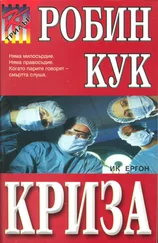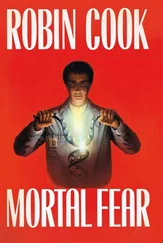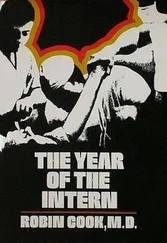“What’s happening now,” said Martin, “is that the machine is making two hundred and forty separate X-ray readings for each single degree of rotational movement.”
One of the medical students made a face of total incomprehension to his colleague. Martin ignored the gesture and placed his face in his hands with his fingers over his eyes, rubbing carefully and then massaging his temples. He hadn’t had his coffee yet and felt groggy. Normally he’d stop in the hospital cafeteria, but this morning he hadn’t had time because of the medical students. Philips, as Assistant Chief of Neuroradiology, always made it a point to handle the medical students’ introduction to neuroradiology. His compulsiveness in this regard had become a pain in the ass because it cut into his research time. The first twenty to thirty times he had enjoyed impressing the students with his exhaustive knowledge of the anatomy of the brain. But the novelty had worn off. Now it was enjoyable only if a particularly smart student came along, and in neuroradiology that didn’t happen very often.
After a few minutes the doughnut-shaped scanner halted its rotational movement, and the computer console came alive. It was an impressive setup like a control panel in a science-fiction movie. All eyes switched from the patient to the blinking lights, except for Philips, who glanced down at his hands and tried to dislodge a small tab of dead skin alongside the nail of his index finger. His mind was wandering.
“In the next thirty seconds the computer simultaneously solves forty-three-thousand-two-hundred equations of tissue-density measurements,” said the technician, eager to take over Philips’ role. Philips encouraged this. In fact he merely gave the students their formal lectures, allowing the practical teaching to be done by the neuroradiology fellows, or the superbly trained technicians.
Lifting his head, Philips watched the medical students, who were transfixed in front of the computer console. Turning his gaze to the leaded window, Philips could just see Mr. Schiller’s bare feet. Momentarily the patient was a forgotten participant in the unfolding drama. For the students the machine was infinitely more interesting.
There was a small mirror over a first-aid cabinet, and Philips looked at himself. He hadn’t shaved yet and the day-old stubble stood out like bristles on a brush. He always arrived a good hour before anyone else in the entire department, and he’d developed the habit of shaving in the surgical locker room. His routine was to get up, jog, shower and shave in the hospital and stop for coffee in the cafeteria. This usually gave him two hours to work in his research interests without interruption.
Still looking in the mirror, Philips ran a hand through his thick sandy hair, pushing it back. There was such a difference between the lightness of the ends and the darker blond of the roots that some of the nurses kidded Philips about highlighting it. Nothing could have been further from the truth. Philips rarely thought about his looks, occasionally butchering his hair himself when he didn’t have time to go to the hospital barber. But despite his inattention, Martin was a handsome man. He was forty-one and the recent lines that had formed about his eyes and mouth only enhanced his appearance, which earlier had seemed a bit boyish. Now he looked harder, and a recent patient had remarked that he seemed more like a cowboy on TV than a doctor. The comment had pleased him and it wasn’t altogether without basis. Philips was just under six feet tall with a slight but athletic build, and his face did not give the impression of an academician. It was angular, with a ruler-straight nose and expressive mouth. His eyes were a lively light blue, and they, more than anything else, reflected his basic intelligence. He’d graduated summa cum laude from Harvard, class of 1961.
The cathode-ray tube on the output console came to life as the first image appeared. The technician hastily adjusted the window width and the density to give the best image. The medical students crowded around the small TV-like screen as if they were about to see the Super Bowl, but the picture they saw was oval with a white border and a granular interior. It was a computer-constructed image of the inside of the patient’s head, positioned as if someone was looking down on Mr. Schiller after the top of his skull had been removed.
Martin glanced at his watch. It was a quarter to eight. He was counting on Dr. Denise Sanger to arrive at any moment and take over shepherding the medical students. What really was on Philips’ mind this morning was a meeting with his research collaborator, William Michaels. Michaels had called the day before, saying that he was coming over early in the morning with a little surprise for Philips. By now Martin’s curiosity had been honed to a razor’s edge, and the suspense was killing him. For four years the two men had been working on a program to enable a computer to read skull X rays, replacing the radiologist. The problem was in programming the machine to make qualitative judgments about the densities of specific areas of X rays. If they could succeed, the rewards would be incredible. Since the problems of interpreting skull X rays were essentially the same as interpreting other X rays, the program would be eventually adaptable to the entire field of radiology. And if they accomplished that... Philips occasionally let himself dream of having his own research department, and even the Nobel Prize.
The next image appeared on the screen bringing Philips’ mind back to the present.
“This slice is thirteen millimeters higher than the previous image,” intoned the technician. With his finger, he pointed to the bottom section of the oval. “Here we have the cerebellum and...”
“There’s an abnormality,” said Philips.
“Where?” asked the technician, who was seated on a small stool in front of the computer.
“Here,” said Philips, squeezing in so that he could point. His finger touched the area the technician had just described as the cerebellum. “This lucency here in the right cerebellar hemisphere is abnormal. It should have the same density as the other side.”
“What is it?” asked one of the students.
“Hard to say at this point,” said Philips. He leaned over to look at the questionable area more closely. “I wonder if the patient has any gait problem?”
“Yes, he does,” said the technician. “He’s been ataxic for a week.”
“Probably a tumor,” said Philips, standing back up.
The faces of all four medical students immediately reflected dismay as they stared at the innocent lucency on the screen. On the one hand they were thrilled to see a positive demonstration of the power of modern diagnostic technology. On the other hand, they were frightened by the concept of a brain tumor; the idea that anybody could have one; even they.
The next image began to wipe off the previous one.
“Here’s another area of lucency in the temporal lobe,” said Philips, quickly pointing to an area already being replaced by the next image. “We’ll see it better on the next slice. But we are going to need a contrast study.”
The technician got up and went in to inject contrast material into Mr. Schiller’s vein.
“What does the contrast material do?” asked Nancy McFadden.
“It helps outline lesions like tumors when the blood brain barrier is broken down,” said Philips, who had turned to see who was coming into the room. He’d heard the door to the corridor open.
“Does it contain iodine?”
Philips hadn’t heard the last question because Denise Sanger had come in and was smiling warmly at Martin behind the backs of the engrossed medical students.
She slipped out of her short white coat and reached up to hang it next to the first-aid cabinet. It was her way of getting down to work. Its effect on Philips was the opposite. Sanger had on a pink blouse, pleated in the front and topped with a thin blue ribbon tied in a bow. As she extended her arm to hang her coat, her breasts thrust against her blouse, and Philips appreciated the image as a connoisseur appreciated a work of art, for Martin thought Denise was one of the most beautiful women he had ever seen. She said she was five-five, whereas actually she was five-four. Her figure was slight, one hundred and eight pounds, with breasts that were not large but wonderfully shaped and firm. She had thick shiny brown hair, which she usually wore pulled back from her forehead and clasped with a single barrette on the back of her head. Her eyes were lighter brown with flecks of gray, giving her a lively, mischievous appearance. Very few people guessed that she had been first in her medical school graduating class three years previously, nor did many believe that she was twenty-eight years old.
Читать дальше












